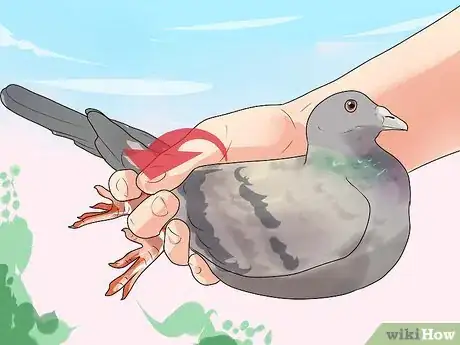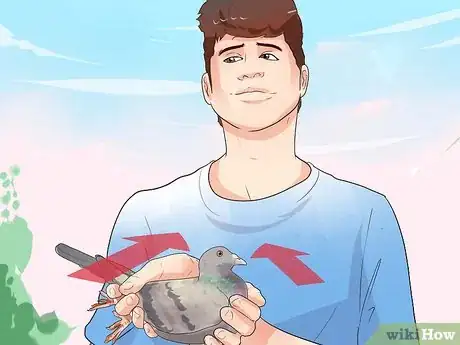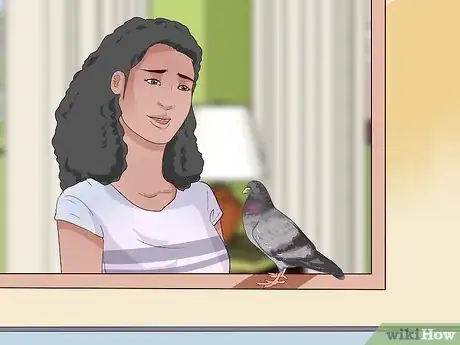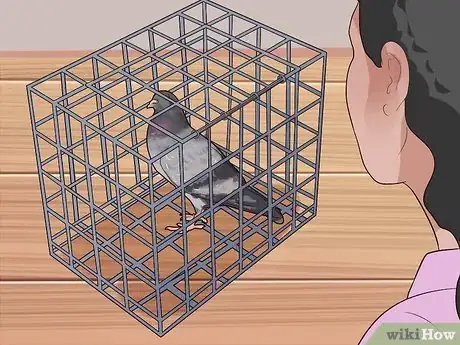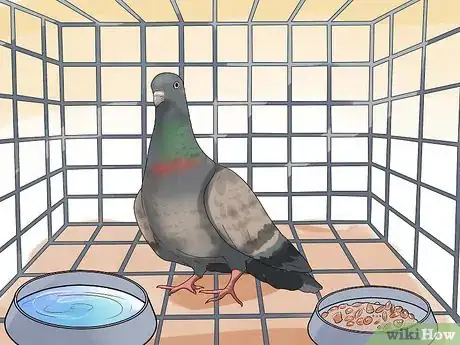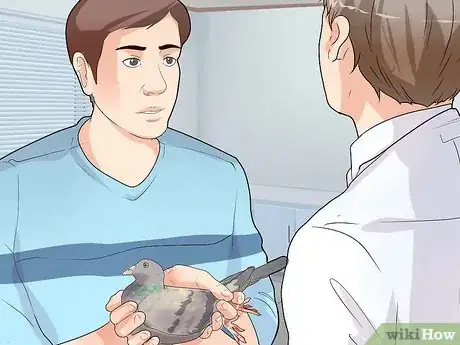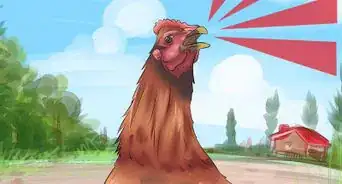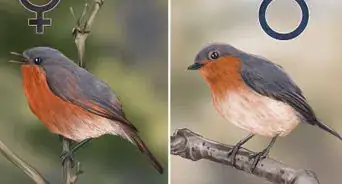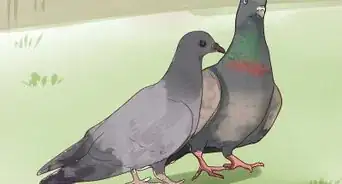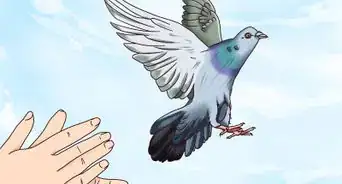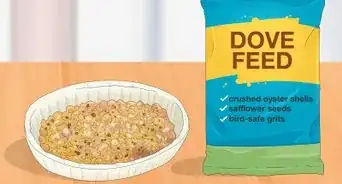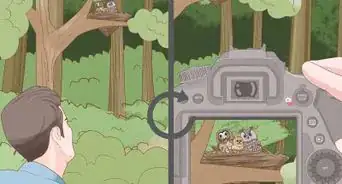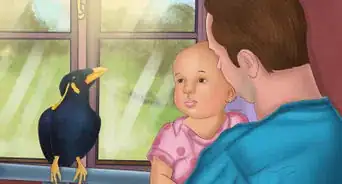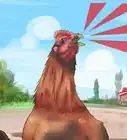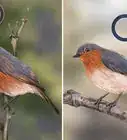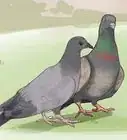This article was co-authored by Pippa Elliott, MRCVS. Dr. Elliott, BVMS, MRCVS is a veterinarian with over 30 years of experience in veterinary surgery and companion animal practice. She graduated from the University of Glasgow in 1987 with a degree in veterinary medicine and surgery. She has worked at the same animal clinic in her hometown for over 20 years.
There are 7 references cited in this article, which can be found at the bottom of the page.
wikiHow marks an article as reader-approved once it receives enough positive feedback. In this case, 89% of readers who voted found the article helpful, earning it our reader-approved status.
This article has been viewed 97,718 times.
Owning a pet pigeon can be a lot of fun. Picking up your pigeon and holding it can be part of that fun. It can also demonstrate a level of trust between you and your pigeon. However, you will need to carefully and properly handle your pigeon. Birds are very fragile creatures and will need you to be gentle when you hold them. Pigeons also get nervous easily, so work slowly and carefully whenever you want to hold it.
Steps
Picking Up a Pigeon
-
1Hold out your dominant hand. When you are picking up a pigeon, you will be using your dominant hand to do so. You will need to hold your hand flat, keep your palm up, and have a slight gap between your index and middle fingers. This will allow you to safely and securely pick up your pigeon.[1]
-
2Slide your hand under the pigeon. Once you have your hand positioned correctly, you will need to slide it underneath the pigeon. Move your hand towards the pigeon slowly as you go to pick it up. Moving too quickly may scare it and cause it to fly away from your hand.[2]
- You will move your hand towards your pigeon's side.
- The pigeon should be facing the outer edge of your hand.
- The pigeon's tail feather should be facing your thumb.
Advertisement -
3Let the pigeon's legs slide between your fingers. Begin by moving your hand underneath your pigeon. As you do, keep a small gap between your pointer and middle fingers to allow space for your pigeon's legs. This will both support and secure the pigeon in your hand.[3]
- The pigeon's legs should gently rest between your fingers.
- Don't hold the legs or the pigeon too tightly.
- Ideally, your pigeon will be in its cage when you try to pick it up.
-
4Wrap your thumb around the pigeon's wings. After the pigeon is in your hand and its legs are between your fingers, you can grasp the bird with your thumb. Bring your thumb down, covering the wings. Keeping its wings secure will help keep your pigeon safe and prevent it from flying away.[4]
- Don't hold the wings down tightly.
- The wings should rest flatly on the pigeon's back.
-
5Bring the bird close to you. After you've gotten a good hold on your pigeon, you can move it towards your body. Bringing it closer to your body will help it feel secure and will allow you to support and hold it safely.[5]
- You can cup the bird with your other hand to provide even more security.
- Move the pigeon slowly to avoid scaring it.
Keeping Your Pigeon Calm
-
1Bond with your pigeon. The more familiar your pigeon is with your presence, the more likely it will be comfortable with you holding it. Make sure you take the time to build a strong bond between you and your pigeon before trying to hold it.[6]
- Spend as much time around your pigeon as you can.
- Try to gently speak with your pigeon throughout the day.
- Always act calmly when near your pigeon.
-
2Remove distractions. A calm pigeon will be more likely to allow you to hold it. Before you attempt to pick your pigeon up and hold it, you will want to make sure it is calm. Keeping a relaxed environment will help keep your pigeon calm and make it feel more comfortable with you picking it up.[7]
- Don't try to pick your pigeon up in a noisy environment.
- Make sure there aren't other pets trying to investigate the pigeon.
- Try not to have other people around when you are interacting with your pigeon.
-
3Don't force interactions. Pushing any interaction with a bird will only make it stressed and break any sense of trust or bond it has with you. Never force your pigeon to let you hold it, allowing it to decide when it feels comfortable with your actions.[8]
- If your pigeon becomes uneasy, stop for a while and let it relax.
- A nervous pigeon may flap its wings quickly and try to escape.
- Birds that are scared will often hold their feathers tight against their body.
- Very frightened birds will hiss at you and try to bite, spreading their wings out while doing so.
Helping a Lost or Wounded Pigeon
-
1Capture the pigeon. The first step in helping a lost or injured pigeon is to capture it safely. The method you use will depend on what condition the bird might be in. Take a look at the following methods that you can use to capture a pigeon:[9]
- Get a container ready to hold the bird once you capture it.
- If possible, put the bird in your container without using your hands to avoid further injury.
- Throwing a blanket over a bird can help contain them while you capture it.
- Leaving food in the container or enclosed room can help lure a bird in.
- If you must, an injured and non-flying bird can usually be captured with just your hands.
-
2Find a safe place for them to rest. If you find a pigeon that needs your help you will need to provide a safe spot for them to rest. Giving them a comfortable space can help them relax and keep stress to a minimum.[10]
- Keep the enclosure clean and dry.
- A bird cage is ideal to use.
- You can use something simple such as a cardboard box. However, you may want to use a mesh covering for the top of it to allow light and air into the box.
-
3Offer them food and water. If the pigeon is lost or injured, it will likely also be hungry and thirsty. While you decide what to do next with the pigeon, make sure you have given them access to fresh food and water.[11] [12]
- Pigeons can eat grains, greens, and seeds. A pigeon can also enjoy most fruits.
- Do not offer your pigeon avocado, as they are thought to be toxic to pigeons.
- Make sure you offer clean water. You can put the water in a simple bowl for them to drink from.
-
4Identify a possible owner. Many pigeons are owned by other people and will have a noticeable band around one of its legs. This band will have a number or code on it that will help identify the owner of the pigeon. If the pigeon is unable to fly back to their owner, you can use this number to help return the bird yourself. Look for some of the following markings on the band to learn more about the owner:[13]
- A.U. stands for the American Racing Pigeon Union
- IF indicates the International Federation
- C.U. stands for the Canadian Racing Pigeon Union
- Other markings may indicate individual owners or private clubs.
-
5Take the pigeon to professional help. Once you've captured the pigeon and cared for its basic needs, you will want to deliver it to someone who can care for it further. Finding either a wildlife rehabilitation center or aviary veterinarian will allow the bird to get the care it needs. These centers can also help the pigeon be reunited with its owner.
References
- ↑ https://www.youtube.com/watch?v=uxUpc1m8o8w
- ↑ https://www.youtube.com/watch?v=uxUpc1m8o8w
- ↑ https://www.youtube.com/watch?v=uxUpc1m8o8w
- ↑ https://www.youtube.com/watch?v=9tvG1ZkZbs4
- ↑ http://www.pigeonrescue.org/faqs-2/how-do-i-hold-a-pigeon/
- ↑ http://www.pigeonrescue.org/faqs-2/how-do-i-hold-a-pigeon/
- ↑ http://www.pigeonrescue.org/faqs-2/how-do-i-hold-a-pigeon/
- ↑ https://lafeber.com/pet-birds/scares-pet-bird/
- ↑ http://www.pigeonrescue.org/resources/in-case-of-emergency/
About This Article
To hold a pigeon, start by slowly sliding your hand under the bird with your palm facing up. As you move your hand underneath, leave a small gap between your fingers for the bird’s legs to slide into. Once the pigeon is in your hand, move your thumb down gently over its wings to keep it safe and prevent it from flying away. Finally, move your hand close to your body to help support the pigeon and hold it safely. For more tips from our Veterinary co-author, like how to keep the pigeon calm, keep reading!



